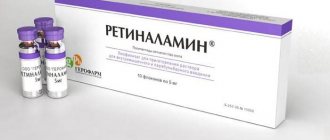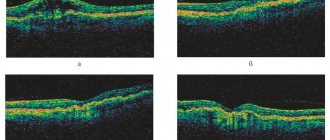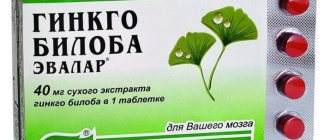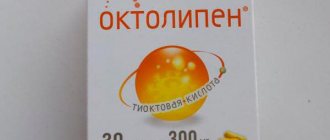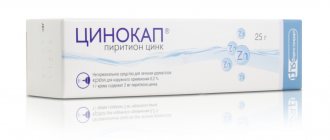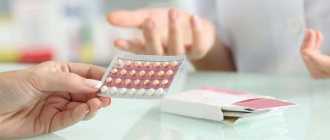Pharmacodynamics and pharmacokinetics
Pharmacodynamics
Inhibits acetaldehyde dehydrogenase , involved in the metabolism of ethyl alcohol . The delay in the oxidation of ethyl alcohol at the acetaldehyde stage causes its accumulation and the development of intoxication - disulfiram-alcohol reaction , which is accompanied by severe sensations and violent vegetative reactions: throbbing pain in the head, noise in the head, tachycardia , decreased blood pressure, palpitations, blurred vision, nausea, vomiting . Unpleasant sensations associated with drinking alcohol lead to a conditioned reflex aversion to alcoholic beverages.
Pharmacokinetics
Absorbed by 70 - 90% after oral administration. It dissolves well in lipids and accumulates in fat depots. It is quickly metabolized, and ultimately, through a series of transformations, turns into an active metabolite - diethylthiocarbamic acid (methyl-DTC). The maximum concentration of which in the blood is determined after 4 hours, however, activity towards acetaldehyde dehydrogenase is observed after 3 days of regular use.
T1/2 of methyl-DTC is 10 hours, but activity against aldehyde dehydrogenase remains longer. Therefore, after discontinuation of the drug, the effect will last 7-14 days. Metabolites are excreted in the urine, partially in exhaled air, and 20% of unchanged disulfiram is excreted through the intestines.
Release form and composition
The dosage form of Antabuse is effervescent tablets: almost white or white, round, flat, with beveled edges:
- dose 0.2 g: one side is divided by a line marked on the sides “CD” | “C” (100 pieces each in high-density polyethylene containers/dark glass bottles with a plastic cap, 1 container/bottle in a cardboard box);
- dose 0.4 g: on one side there is a cross-shaped mark dividing the tablet into four equal parts, and the marking “CJ” (50 pieces each in high-density polyethylene containers / dark glass bottles with a polyethylene cap, 1 container / bottle in a cardboard pack).
1 effervescent tablet contains:
- active ingredient: disulfiram – 0.2 g or 0.4 g;
- auxiliary components: povidone, corn starch, tartaric acid, talc, magnesium stearate, sodium bicarbonate, colloidal silicon dioxide, microcrystalline cellulose.
Contraindications
Absolute contraindications:
- neuritis of the auditory and optic nerve ;
- diseases of the cardiovascular system (severe cardiosclerosis , post-infarction conditions, cerebral , aortic aneurysm , hypertension);
- polyneuritis of any origin;
- glaucoma;
- emphysema , bronchial asthma ;
- pulmonary tuberculosis;
- mental illness, epilepsy and epileptiform syndrome;
- diabetes;
- severe liver and kidney failure ;
- thyrotoxicosis;
- diseases of the hematopoietic organs;
- exacerbation of peptic ulcer ;
- malignant tumors;
- pregnancy;
- increased sensitivity.
Relative contraindications include other cardiovascular diseases, age over 60 years, peptic ulcer disease in remission, consequences of strokes with residual effects, a history of antabuse psychoses
special instructions
Patients taking Antabuse should monitor prothrombin levels and adjust the dosage of anticoagulant drugs. Otherwise, the risk of bleeding cannot be avoided.
Pregnancy and lactation period
Pregnant and lactating women are strictly prohibited from taking the drug.
Childhood
The drug is not prescribed to persons under 18 years of age.
Elderly age
Persons over 60 years of age are prohibited from taking the medication.
Liver diseases
Severe liver damage is a contraindication for prescribing the drug.
Kidney failure
If a patient is diagnosed with renal failure, the drug is not prescribed.
Side effects
Antabuse can cause the following reactions due to the action of disulfiram :
- hepatitis;
- metallic taste in the mouth;
- polyneuritis of the lower extremities;
- memory loss, headaches;
- asthenia;
- Optic neuritis;
- skin manifestations.
Reactions caused by the combined use of disulfiram and alcohol:
- respiratory failure;
- heart rhythm disturbances;
- myocardial infarction , angina pectoris ;
- cardiovascular collapse;
- cerebral edema;
- cerebral thrombosis;
- psychoses.
Compatibility with alcohol and other drugs
Antabuse and ascorbic acid reduce the body's reaction to alcohol-containing drinks. The drug is also not taken with derivatives of 5-nitroimidazole, Isoniazid, Phenytoin.
with caution with drugs such as Theophylline, Warfarin, tricyclic antidepressants and benzodiazepines .
Possibility of combining with alcohol
The drug and alcohol are incompatible (except for routine tests). Their combined use threatens depression of consciousness, collapse of the cardiovascular system, and neurological complications.
Instructions for use of Antabuse (Method and dosage)
The tablets are taken orally, dissolved in 0.5 glasses of water. Take 200–500 mg 1–2 times a day, the regimen is prescribed by a doctor. A week later, a disulfiram-alcohol test is carried out - in parallel with taking 500 mg of Antabuse, the patient drinks 20-30 ml of vodka. The body's reaction is observed, and if the reaction is weak, the dose of alcohol is increased by 20 ml. The test is repeated several times, and the dose of alcohol and the drug is adjusted. Subsequently, a maintenance dose of 200 mg/day is used for 1 to 3 years.
The instructions for use of Antabuse contain warnings that the drug is prescribed after an examination and mandatory warning of the patient about complications. With prolonged therapy, the development of psychosis , thrombosis of cerebral vessels , and exacerbation of polyneuritis .
Antabus®
This drug should only be used under the supervision of a doctor.
Before starting treatment with Antabuse, liver function should be determined, including determination of the activity of microsomal liver enzymes. This examination should be carried out in the first 3 months of treatment at least once every two weeks, then at least once every 3-6 months. If the activity of microsomal liver enzymes increases by less than 3 times, it is necessary to assess the risks of using the drug and strengthen monitoring of the patient’s condition. Exceeding the upper limit of normal activity of microsomal liver enzymes by 3 times or more requires immediate cessation of treatment. In this case, the patient should be carefully monitored until liver function tests normalize.
Patients should be instructed to immediately report to their healthcare provider the following symptoms: fatigue, anorexia (lack of appetite), nausea, vomiting, fever, itching, jaundice. dark urine or discolored stool, which may be symptoms of hepatitis. If they appear, you should immediately stop taking the drug and conduct an examination of the patient, including a clinical examination and laboratory examination (assessment of the functional state of the liver).
Taking Antabuse can cause drug-induced liver damage. Fatal cases have been reported (see Side Effects section).
You should not take Antabuse during alcohol intoxication. You should not drink alcohol during treatment with Antabuse, except in cases where the attending physician selects the dose and conducts a disulfiram-ethanol test.
When conducting a disulfiram-ethanol test in patients taking Antabuse, great care should be taken. The intensity of the disulfiram-ethanol reaction is dose dependent and varies from person to person. A reaction may occur within 14 days after stopping therapy with Antabuse. There may be no reaction to drinking alcohol the first time you take it during treatment, or a very severe reaction may occur.
The drug should not be used without notifying the patient about it.
Patients should be warned about the danger of an alcohol intolerance reaction, which can begin 10 minutes after drinking alcohol and last up to several hours. A reaction to ethanol may occur within 14 days after therapy with Antabuse.
Disulfiram prevents the metabolism of ethanol, causing acetaldehyde to accumulate in the body, which can lead to the disulfiram-ethanol reaction.
The disulfiram-ethanol reaction is characterized by a “flush” of blood to the facial skin, shortness of breath, headache, increased heart rate, tachycardia, decreased blood pressure, nausea and vomiting. Severe disulfiram-ethanol reactions can be manifested by the following symptoms: cardiac arrhythmias, angina attacks, collapse, myocardial infarction, sudden death, respiratory depression, neurological disorders (confusion, encephalopathy and epileptic seizures). There have been rare reports of deaths from alcohol consumption during treatment with Antabuse.
It is assumed that when conducting a disulfiram-ethanol test, resources are available to carry out measures to eliminate low blood pressure: transfer of the patient to the Trendelenburg position, oxygenation and intravenous infusion solutions. Administration of pressor amines such as norepinephrine may be required.
The patient and family members should be warned that some foods (eg, sauces), including products labeled "non-alcoholic" (beer, wine), and some medications (eg, cough syrups) may contain trace amounts of the amount of ethanol that can provoke a disulfiram-ethanol reaction. This also applies to aftershave products, cosmetics and perfumes. During the treatment period, the patient should avoid the use and consumption of these products. The reaction to ethanol may be enhanced by the simultaneous use of amitriptyline and chlorpromazine and weakened by diazepam.
Alcohol should not be consumed for at least 14 days after stopping Antabuse therapy.
The disulfiram-ethanol reaction is initiated by histamine, as a result of which its symptoms may be masked when taking antihistamines and other drugs with antihistamine action.
When used simultaneously with indirect anticoagulants, it is necessary to carry out more frequent monitoring of MHO (international normalized ratio) and adjustment of doses of anticoagulants at the beginning of taking disulfiram and within 8 days after its discontinuation, due to the increased risk of bleeding. Antabuse should be taken with caution in patients with renal, liver failure or hypothyroidism, as well as in patients with diseases of the respiratory system, diabetes mellitus, brain damage and epilepsy, especially at the risk of a possible combination with alcohol due to the danger of a severe disulfiram-ethanol reaction.
Interaction
An unacceptable combination is taking alcoholic beverages, alcohol-containing drugs and products, since an intolerance reaction occurs.
Metronidazole , Tinidazole , Ordinazole , Secnidazole , when taken simultaneously with Antabuse, cause delirious disorders and disturbances of consciousness.
When taken with phenytoin , a significant increase in its plasma level occurs with the development of toxic symptoms.
The anti-tuberculosis drug Isoniazid may cause problems with coordination.
Antabuse increases the effect of oral anticoagulants ( Warfarin ), which creates a risk of bleeding .
Disulfiram inhibits theophylline , so its dose should be reduced.
Potentiates the sedative effect of benzodiazepines ( Chlordiazepoxide and Diazepam ), the dosage of which should be reduced.
Neutralization capabilities
The effect of the drug Antabuse cannot be neutralized in any way - all patients should be warned about this in advance. That is why everyone undergoing treatment with the drug is strictly prohibited from drinking any alcohol-containing drinks or visiting a bathhouse or sauna. Ignoring these warnings can result in serious consequences.
Analogs
Level 4 ATC code matches:
Antaxon
Metadoxyl
Vivitrol
Naltrexone
Medichronal
Disulfiram
Teturam
Colma
Proprothene-100
Lidevin
Esperal
Tablets Lidevin , Teturam , Esperal .
Reviews about Antabuse
Anti-relapse and maintenance treatment of alcoholism is carried out with medications: Disulfiram , Naltrexone and Acamprosate . An innovative form of disulfiram is “effervescent” Antabuse tablets, which dissolve in water and are tasteless and odorless. The drug, when taken together with alcohol, causes unpleasant (aversive), painful sensations: fear of death , shortness of breath, a feeling of lack of air, etc. Fear of death, the main manifestation of the action of disulfiram, forces an alcoholic patient to stop drinking alcohol.
Reviews from doctors boil down to warnings about serious complications of disulfiram-alcohol reaction. Considering this and the large number of contraindications, the drug is prescribed only by a doctor, and treatment must be carried out under the supervision of a narcologist. You cannot carry out treatment yourself in secret from the patient, since the phenomena caused by the drug can be so pronounced that resuscitation measures are required. The patient should be informed that drinking a small dose of alcohol while taking Antabuse can be fatal. Before prescribing the drug, it is necessary to conduct an examination and the patient himself must confirm that he wants to get rid of alcoholism.
Doctors remind that, unfortunately, there are no sufficiently effective medications that suppress the desire for ethyl alcohol. And this method is not a treatment, but a “prohibitive method” so that the patient has no way to retreat and has the opportunity to achieve stable remission. Treatment of alcoholism should be comprehensive (psychological assistance, acupuncture, sedatives and a strong desire to quit drinking). And the reviews about Antabuse are proof of this. Many patients took it for several years, but the craving for alcohol persisted, and only the fear of physical pain and death held them back.
“I took it 5 years ago under the supervision of a narcologist and psychologist. I broke down several times, but now I can control myself - a psychologist helps."
“I always had a craving for alcohol, but Antabuse always held me back and stopped me.”
Description
International nonproprietary name: INN of the drug – Disulfiram (Latin name Antabus tablet)
ATC classification code: The drug was registered on July 28, 2008. In the ATC it is listed as N07BB01 (Disulfiram) . LSR-005928.08.
Purpose: Prescribed for therapeutic treatment of people suffering from chronic alcoholism.
Terms of sale: The drug is sold in pharmacies only by prescription.
Cost: You can buy the medicine at a price of 128 rubles. and above (1 package contains 100 effervescent tablets).
Storage conditions: Store the drug at a temperature not exceeding + 30C in a place inaccessible to children and animals.
Expiration dates
: No more than 5 years from the date of manufacture.
Country of origin: Produced in Iceland by the pharmaceutical concern Actavis Group.
